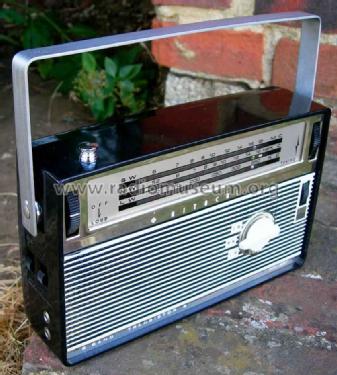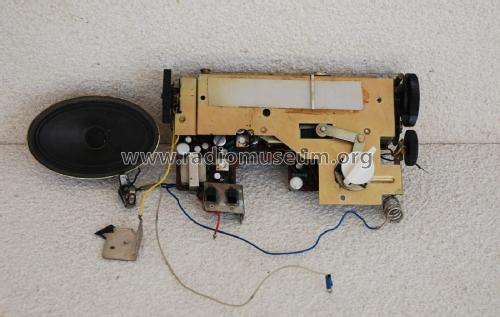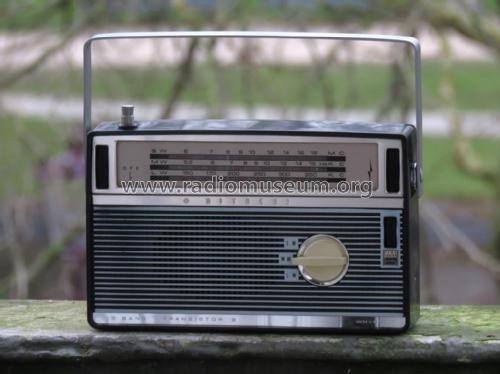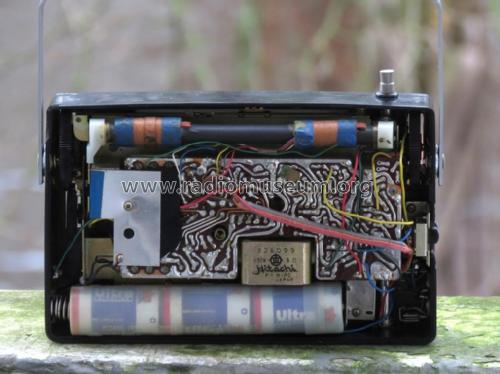WH-837
Hitachi Ltd.; Tokyo
- País
- Japon
- Fabricante / Marca
- Hitachi Ltd.; Tokyo
- Año
- 1965 ?
- Categoría
- Radio - o Sintonizador pasado WW2
- Radiomuseum.org ID
- 176228
-
- alternative name: Hitachi Sales Corp. of America
Haga clic en la miniatura esquemática para solicitarlo como documento gratuito.
- Numero de transistores
- 8
- Principio principal
- Superheterodino en general; ZF/IF 455 kHz; 3 Etapas de AF
- Número de circuitos sintonía
- 5 Circuíto(s) AM
- Gama de ondas
- OM, OL y OC
- Tensión de funcionamiento
- Pilas / 3 x 1.5 Volt
- Altavoz
- Altavoz elíptico de imán permanente.
- Material
- Plástico moderno (Nunca bakelita o catalina)
- de Radiomuseum.org
- Modelo: WH-837 - Hitachi Ltd.; Tokyo
- Forma
- Portátil > 20 cm (sin la necesidad de una red)
- Ancho, altura, profundidad
- 8.75 x 7.5 x 2.5 inch / 222 x 191 x 64 mm
- Anotaciones
-
Hitachi WH-837: Portable radio with fine tuning, tone switch, sensitive/local-station switch and earphone jack. SW band 6 to 18 MHz. Elliptical loudspeaker 4 x 2.5 inch.
Model WH-837 comes in 2 distinct versions: a single-print-version and version with two prints. On the outside the only difference is the head of the telescopic antenna. The antenna with 'high hat' belongs to the single-print-version. The antenna with 'flat cap' belongs to the version with two prints.
See also model WH-837E.
- Procedencia de los datos
- -- Schematic
- Referencia esquema
- Radio and TV Servicing books (R&TVS) book
- Autor
- Modelo creado por Keith Staines. Ver en "Modificar Ficha" los participantes posteriores.
- Otros modelos
-
Donde encontrará 1063 modelos, 953 con imágenes y 255 con esquemas.
Ir al listado general de Hitachi Ltd.; Tokyo
Colecciones
El modelo es parte de las colecciones de los siguientes miembros.
Contribuciones en el Foro acerca de este modelo: Hitachi Ltd.; Tokyo: WH-837
Hilos: 1 | Mensajes: 3
Es schwirren von diesem Gerät ein paar Versionen herum, die scheinbar den gleichen Modellnamen haben. Da ist das Modell WH-837E, das heisst weningstens leicht anders, da es ein angefügtes E hat. Da ist mein Modell, das Radio auf einer Printplatte, und da ist eines der Radios im radiomuseum: hier ist die Printplatte in der Mitte entzweigeschnitten: der HF-Teil ist sozusagen in der normalen Position, Leiterbahnen sichtbar, der Rest ist einfach umgedreht – wodurch man plötzlich auf die Bauteile blickt. Bei mir sind natürlich ebenfalls Leiterbahnen zu sehen, aber überall, ist die Platte doch aus einem Stück.
Wie kann es sein, dass ein Modell zwei Versionen hat, die so wesentlich voneinander abweichen, ohne dass es zwei Modellnummern bekommen hat? – Zugegeben, von aussen sind sie sich gleich, aber das Innenleben lässt einem die Haare zu Berge stehen, wenn man die Radios nebeneinander stellt. Das mache ich gleich hier unten mit den zwei Bildern, was tun die Haare der Betrachter jetzt?
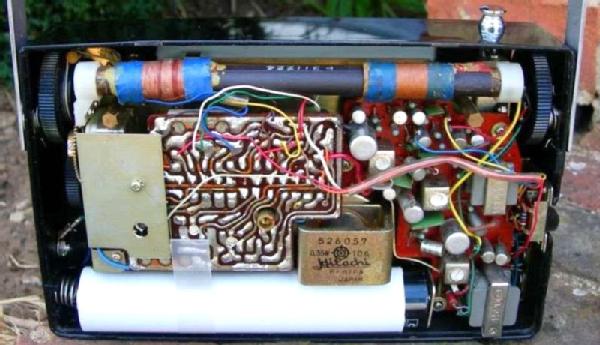
Muss man als Museumwärter hier nicht an zwei Modelle in der Sammlung denken, an eines mit durchgehender Platine, und an eines mit zweitteiliger Platine? – Oder ist die Frage zu lösen mit 2 Versionen?
Bruce Cohen, 28.Dec.24



